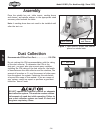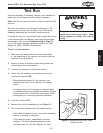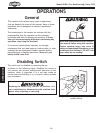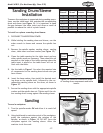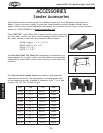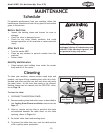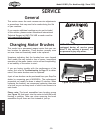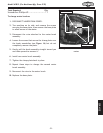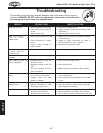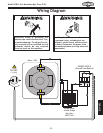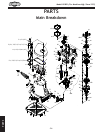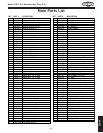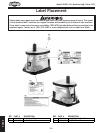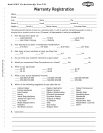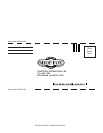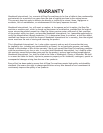
-22-
Model W1831 (For Machines Mfg. Since 2/12)
SERVICE
Troubleshooting
This section covers the most common problems and corrections with this type of
machine. WARNING! DO NOT make any adjustments until power is disconnected
and moving parts have come to a complete stop!
PROBLEM POSSIBLE CAUSE CORRECTIVE ACTION
Motor will not start. 1. Switch disabling key removed.
2. Loose connections at motor or
switch.
3. Motor brushes worn.
1. Insert key to enable switch.
2. Inspect all motor connections for loose or open
connections.
3. Replace motor brushes as a set.
Motor will not start;
fuses or circuit
breakers blow.
1. Short circuit in line cord or plug.
2. Loose connections at motor
switch.
3. Switch, bridge rectifier or
motor at fault.
1. Inspect cord and plug for damaged insulation
or shorted wires.
2. Inspect all motor connections for loose or
shorted terminals or worn insulation.
3. Replace the component at fault.
Motor stalls (resulting
in blown fuses or
tripped circuit).
1. Motor overloaded. 1. Reduce feeding pressure.
Machine slows when
operating.
1. Workpiece pressure is too great. 1. Secure machine to workbench.
Deep sanding grooves or
scars in workpiece.
1. Sanding sleeve too coarse for
the desired finish.
2. Workpiece sanded across the
grain.
3. Too much feeding pressure
against workpiece.
1. Use a finer grit sanding sleeve.
2. Sand with the grain.
3. Reduce pressure on workpiece while sanding.
Grains rub off the sanding
sleeve.
1. Sanding sleeve has been stored
in an incorrect environment.
2. Sanding sleeve has been
folded or smashed.
1. Store sanding sleeve away from extremely dry
or hot temperatures.
2. Store sanding sleeves separately and not folded
or flat.
Sanding surfaces clog
quickly or burn.
1. Too much pressure against sleeve.
2. Sanding softwood or wood
with a high sap content.
1. Reduce pressure on workpiece while sanding.
2. Either use different wood or plan on cleaning/
replacing sleeves frequently.
Burn marks on workpiece. 1. Using too fine of sanding grit.
2. Using too much pressure.
3. Work held still for too long.
1. Use a coarser grit sanding sleeve.
2. Reduce pressure on workpiece while sanding.
3. Do not keep workpiece in one place for too long.



